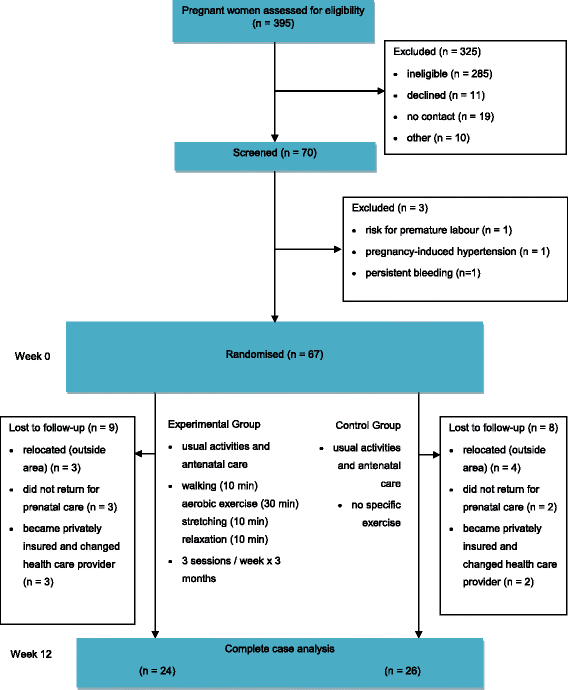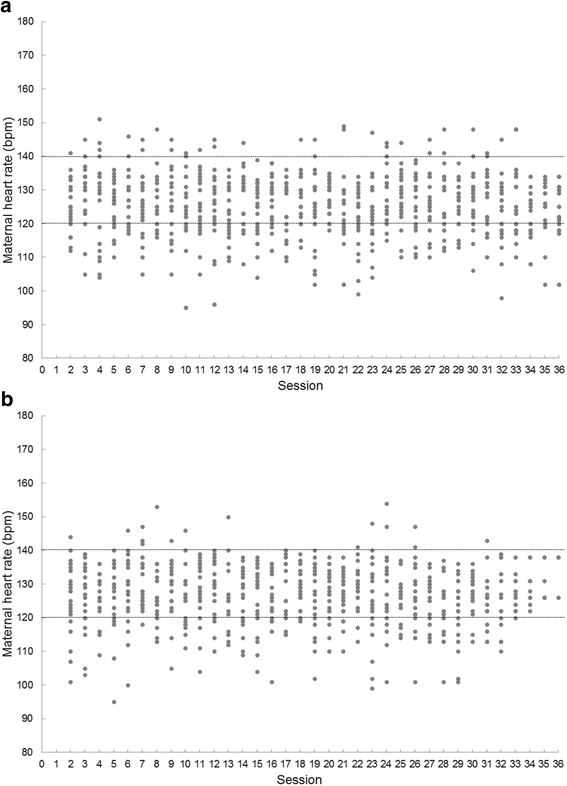Exercise during pregnancy on maternal lipids: a secondary analysis of randomized controlled trial
- PMID: 29179683
- PMCID: PMC5704449
- DOI: 10.1186/s12884-017-1571-6
Exercise during pregnancy on maternal lipids: a secondary analysis of randomized controlled trial
Abstract
Background: Today, scientific evidence has supported the popular belief that physical activity is associated with biological health in pregnant women. A randomized controlled trial was used to assess the benefits of physical exercise during pregnancy on maternal lipids in low-income Latina women.
Methods: The study included 67 nulliparous low-income Latina women in gestational weeks 16–20, randomly assigned into one of two groups: 1) The exercise group, which took part in aerobic and resistance exercise for 60 min, three times a week for 12 weeks, 2) The control group, which undertook their usual physical activity and prenatal care. The primary outcomes were changes in maternal blood lipids after intervention. Obstetrical and neonatal outcomes measured were type of delivery, postpartum hemorrhage, newborn and/or maternal complications’, gestational age, weight gain, birth weight, foetal growth, and Apgar score.
Results: Fifty women completed the study. At the end of the intervention, there were differences between groups in low-density lipoprotein levels (mean change: −8 mg/dL, 95%CI -3 to −29; P < 0.001) and triglycerides (mean change: −6 mg/dL, 95%CI -1 to −11; P = 0.03). Also, compared with women who remained in the control group, active women showed lower complications during delivery (moderate postpartum haemorrhage) (58% compared with 75%; P < 0.05) and lower complications in newborns (e.g. cyanosis or respiratory distress) (21% compared with 46%; P < 0.001).
Conclusions: An exercise programme during the second and third trimester favours less gain in low-density lipoprotein cholesterol and triglycerides fewer delivery and neonatal complications.
Trial registration:
Keywords: Metabolic biomarkers; Obstetric outcomes; Physical activity; Prenatal.
Conflict of interest statement
Ethics approval and consent to participate
The study was conducted according to the guidelines in the Declaration of Helsinki. A comprehensive verbal description of the nature and purpose of the study and of its experimental risks was presented to all subjects. In the case of participants under 18, this information was provided to their parents/guardians. All participants and the parents/legal guardians of minors under 18 gave their informed written consent before the study began. The study was approved by the Committee for Medical Research Ethics (UV Res. 004/08; N°142–07) and was registered with
Consent for publication
Not applicable.
Competing interests
The authors declare that they have no competing interests.
Publisher’s Note
Springer Nature remains neutral with regard to jurisdictional claims in published maps and institutional affiliations.
Figures


Similar articles
-
Associations between maternal lipid profile and pregnancy complications and perinatal outcomes: a population-based study from China.BMC Pregnancy Childbirth. 2016 Mar 21;16:60. doi: 10.1186/s12884-016-0852-9. BMC Pregnancy Childbirth. 2016. PMID: 27000102 Free PMC article.
-
Adverse obstetrical and neonatal outcomes in elective and medically indicated inductions of labor at term.J Matern Fetal Neonatal Med. 2013 Nov;26(16):1595-601. doi: 10.3109/14767058.2013.795533. Epub 2013 May 15. J Matern Fetal Neonatal Med. 2013. PMID: 23581489
-
An assessment of the hazards of amniocentesis. Report to the Medical Research Council by their Working Party on Amniocentesis.Br J Obstet Gynaecol. 1978;85 Suppl 2:1-41. Br J Obstet Gynaecol. 1978. PMID: 104726 No abstract available.
-
[Hemorrhage after delivery of the infant].Gynakologe. 1991 Jun;24(3):160-9. Gynakologe. 1991. PMID: 1894182 Review. German. No abstract available.
-
[Diabetes mellitus and pregnancy].Sov Med. 1972 Jun;35(6):41-9. Sov Med. 1972. PMID: 4585124 Review. Russian. No abstract available.
Cited by
-
Exercise versus Metformin to Improve Pregnancy Outcomes among Overweight Pregnant Women: A Systematic Review and Network Meta-Analysis.J Clin Med. 2021 Aug 7;10(16):3490. doi: 10.3390/jcm10163490. J Clin Med. 2021. PMID: 34441786 Free PMC article. Review.
-
Population-based plasma lipidomics reveals developmental changes in metabolism and signatures of obesity risk: a mother-offspring cohort study.BMC Med. 2022 Jul 25;20(1):242. doi: 10.1186/s12916-022-02432-y. BMC Med. 2022. PMID: 35871677 Free PMC article.
-
Acute Postexercise Change in Circulating Irisin Is Related to More Favorable Lipid Profile in Pregnant Women Attending a Structured Exercise Program and to Less Favorable Lipid Profile in Controls: An Experimental Study with Two Groups.Int J Endocrinol. 2019 Feb 28;2019:1932503. doi: 10.1155/2019/1932503. eCollection 2019. Int J Endocrinol. 2019. PMID: 30944566 Free PMC article.
-
Perinatal Exercise and Cardiovascular Disease Risk.JACC Adv. 2025 Jun;4(6 Pt 1):101776. doi: 10.1016/j.jacadv.2025.101776. Epub 2025 May 12. JACC Adv. 2025. PMID: 40359645 Free PMC article. Review.
-
Prenatal Factors Associated with Maternal Cardiometabolic Risk Markers during Pregnancy: The ECLIPSES Study.Nutrients. 2023 Feb 23;15(5):1135. doi: 10.3390/nu15051135. Nutrients. 2023. PMID: 36904135 Free PMC article.
References
-
- Sanabria-Martínez G, García-Hermoso A, Poyatos-León R, Álvarez-Bueno C, Sánchez-López M, Martínez-Vizcaíno V. Effectiveness of physical activity interventions on preventing gestational diabetes mellitus and excessive maternal weight gain: a meta-analysis. BJOG. 2015;122(9):1167–1174. doi: 10.1111/1471-0528.13429. - DOI - PubMed
Publication types
MeSH terms
Substances
Grants and funding
LinkOut - more resources
Full Text Sources
Other Literature Sources
Medical

